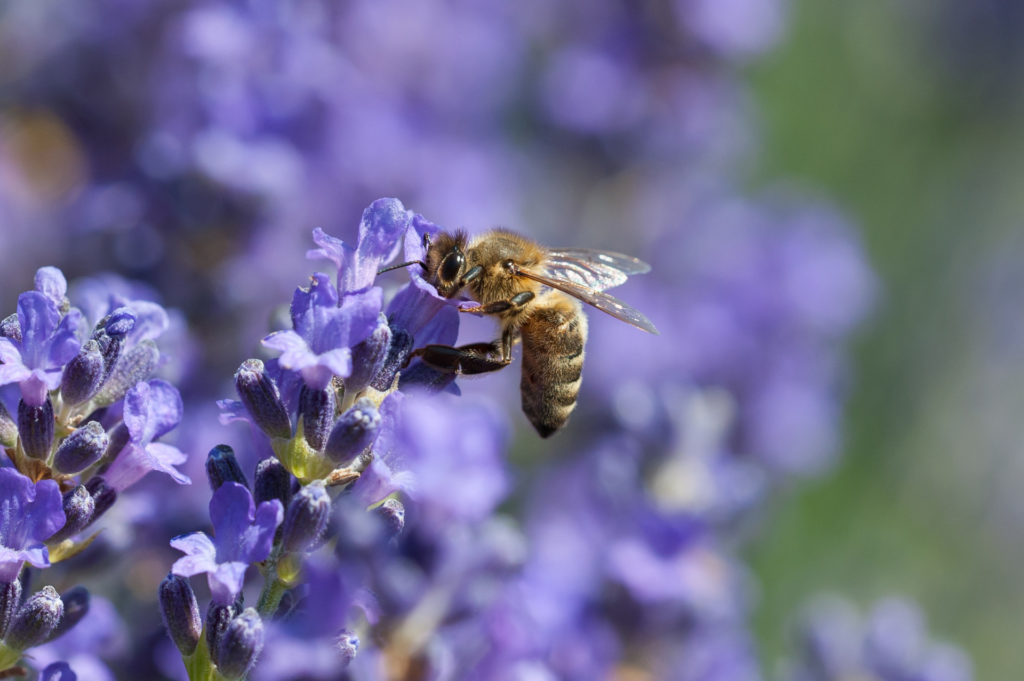
If you notice this spring that campus is buzzing more than usual, that’s likely because of a new commitment to being mindful of bees and other pollinators, their habitat and nutritional needs, and how the campus can play a role.
As part of the university’s commitment to sustainability, a committee comprised of Facilities Management, Environmental Health Services, university entomology and horticulture professors, student representatives from several areas on campus, and other experts have worked to develop a proactive plan to help bees and other pollinating insects and animals that already come to campus looking for pollinating plants and shelter.
“Our university grounds are actually a giant garden and arboretum, comprised of hundreds of flower beds, blooming trees and lush green space,” said Fred Haberecht, associate director of Facilities Management and chair of the pollinator-friendly committee. “This new commitment leverages those spaces to the benefit of pollinators that we know already pass through or live on campus.”
As part of these efforts, the university obtained Bee Campus USA certification last fall, as a testament to the university’s commitment to the role of bees and other pollinators in sustainability. The first campus in Colorado to obtain the certification, the designation reflects a commitment to manage campus landscapes in more pollinator-friendly ways, including minimizing harm to pollinators through steps such as reducing pesticide use or using only bee-friendly pesticides, as well as focusing on pollinator-friendly plants and other supportive approaches.
The strategy involves creating a habitat plan for pollinators, such as recreating several flowerbeds on campus to specifically support pollinating insects and wildlife. Cultivating these areas also create example flower beds that people can visit to learn more about pollinators, plants that support them, and their habitat.
“Campus has always had these spaces,” said Holly Miller, a horticulture technician for Facilities Management. “We’re now focusing with more intention on helping make our pollinators stronger by leveraging our landscape specifically to support them.”
Pollinators already on campus, which will be supported through these efforts, include bees, moths, birds, butterflies and bats.
Redesigned flowerbeds
The first flowerbed to be redesigned as pollinator friendly was on the north side of the Clark A wing, and others have followed, including a bed near the Computer Sciences building and planned work near the Rec Center patio. It will attract pollinators through thoughtful planting that provides blooms through the entire growing season and give pollinators proper nutrition. Plants include catmint, verbena, English lavender, beebalm, spirea and black-eye Susan’s. It also will sport bee hotels, which are structures that support the larva stage of a bee’s reproductive cycle, as well as provide shelter and water for pollinators. Flowers in the bed will bloom until the first frost.
Miller focuses on planting beds with perennials, which offer more nutrition and habitat for pollinators. Each bed takes about three years to fully reach its full potential. As part of an overall campus strategy, and particularly in pollinator beds, Miller plants native and nonnative adapted flowering plants of many varieties, such as primrose and lavender, and aims for a variety in one place that will bloom from early spring to the first frost, mixing texture and colors. She’s also building and installing about 20 bee hotels out of old, untreated lumber to place in the beds.
The university has also developed a response plan for swarming and nuisance insects, such as wasps or hornets.
“Anyone concerned about bee swarms, nuisance bees, wasps or hornets, should contact Environmental Health Services. Environmental Health Services will manage next steps, including calling beekeepers for assistance in removing a swarm,” Haberecht said. While bees can sting if provoked, they are not aggressive like some species of wasps and hornets, which are responsible for the vast majority of stings.
Planting for pollinator tips from Holly Miller, CSU horticulture technician
- Plant native or non-native adapted plants and aim for a variety of plants that provide blooms from early spring through the first frost
- Mix textures and colors
- Create a color pallet that works with the surroundings. For example, Miller plants blues against many of CSU’s red flagstone walls
- Consider drip irrigation; it is best for both plants and pollinators.
- Keep a journal of your garden and landscaping to help you track plants and how well they do in certain locations. Take photographs of your garden throughout the season so you can keep a visual track of how things are progressing.
- Ask lots of questions at your local nursery and seek their opinion on plant recommendations, even consider bringing photos of your house and flower beds
Miller’s recommended reading and resources:
Plant Select book “Pretty Tough Plants; 135 Resilient, Water-Smart Choices for a Beautiful Garden,” now available through Amazon, Barns and Noble and local garden centers
CSU Extension fact sheets:
According to the American Beekeeping Federation, one out of every three bites of food Americans eat is directly or indirectly derived from honeybees, yet honeybees have faced a steep population decline due to pesticides and disease. Other important pollinators, such as bats, also face significant population challenges.
In addition to recreating spaces on campus, campus experts Miller, Arathi Seshadri, a soil and crop sciences assistant professor, her graduate student Lisa Mason, and Rhonda Khosla, a research assocaite in horticulture, engage campus and the public through learning opportunities such as workshops. Facilities Management has also developed signs about pollinators to install at the redesigned beds.